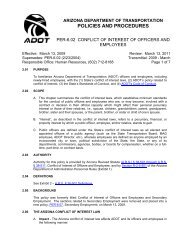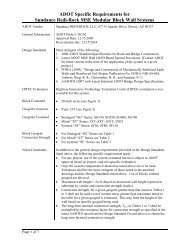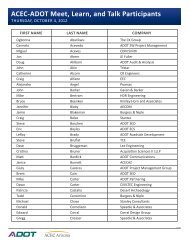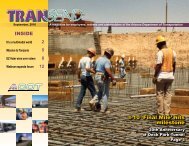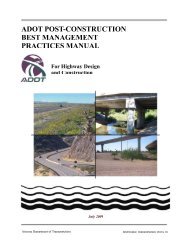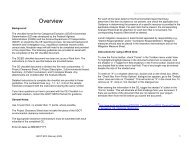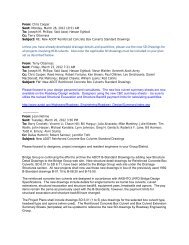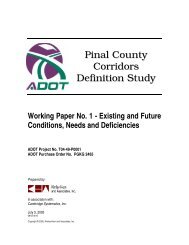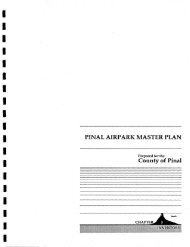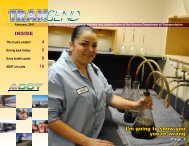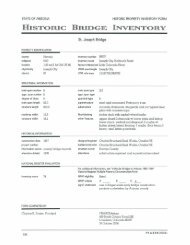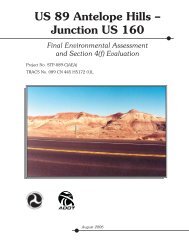I-10 Twin Peaks Traffic Interchange, Environmental Assessment
I-10 Twin Peaks Traffic Interchange, Environmental Assessment
I-10 Twin Peaks Traffic Interchange, Environmental Assessment
Create successful ePaper yourself
Turn your PDF publications into a flip-book with our unique Google optimized e-Paper software.
Affected Environment and <strong>Environmental</strong> Impacts October 2005<br />
The monitoring data indicate that the study area generally meets the NAAQS for<br />
monitored pollutants; however, particulate matter and CO are of general concern<br />
in the study area and Pima County. The project area lies completely within the<br />
boundaries of the Rillito Planning Area, which has been designated by EPA as a<br />
moderate nonattainment area for PM<strong>10</strong>. As opposed to the remainder of Pima<br />
County, which is under the auspices of PDEQ, the ADEQ has regulatory authority<br />
in the Rillito Planning Area. The primary sources of particulate emissions in this<br />
area include the Arizona Portland Cement Company, construction, unstabilized<br />
river banks, agriculture, unpaved roads, and unstabilized road shoulders. The<br />
Rillito PM<strong>10</strong> State Implementation Plan (SIP) was submitted to EPA in April 1994,<br />
but was never approved by EPA. However, the SIP does not include extraordinary<br />
particulate (dust) control mechanisms. According to ADEQ, compliance with Pima<br />
County’s Natural Events Action Plan (discussed in the following paragraph),<br />
ADOT standard specifications for dust suppression during construction, and the<br />
completion of a SWPPP would comply with the submitted Rillito Planning Area<br />
SIP.<br />
Table 4-5. National and State Ambient Air Quality Standards<br />
National and State Standards<br />
Pollutant Averaging Period Primary Secondary<br />
Carbon Monoxide<br />
(CO)<br />
Suspended<br />
Particulate Matter<br />
(PM<strong>10</strong>)<br />
8-Hour 9 ppm No Standard<br />
1 Hour 35 ppm No Standard<br />
24-Hour<br />
150 µg/<br />
m 3<br />
Same as Primary Standard<br />
Annual Arithmetic<br />
50 µg/ m<br />
Mean<br />
3 Same as Primary Standard<br />
Source: EPA (49 CFR 50).<br />
Abbreviations: ppm: parts per million, µg/m 3 : micrograms per cubic meter<br />
Although still considered an attainment area, Pima County exceeded the PM<strong>10</strong><br />
NAAQS six times in 1999. As a result, PDEQ developed a Natural Events Action<br />
Plan (NEAP) to protect public health, educate the public about high wind events,<br />
mitigate health impacts from future events, and identify and implement control<br />
measures for man-made sources of dust. The NEAP (and the ensuing Pima County<br />
ordinance) requires an activity permit from the PDEQ before activities such as<br />
earthmoving, trenching, or road construction are conducted. The ordinance also<br />
limits the amount of dust generated from these activities to a maximum opacity<br />
(cloudiness) of 20 percent. In addition to the NEAP, dust generation is also limited<br />
through grading permits issued by the Town of Marana and by ADOT standard<br />
specifications for dust suppression during construction.<br />
Interstate <strong>10</strong> <strong>Traffic</strong> <strong>Interchange</strong> at<br />
<strong>Twin</strong> <strong>Peaks</strong>/Linda Vista<br />
4-46<br />
Project No.: NH-0<strong>10</strong>-D (AIW)<br />
TRACS No.: <strong>10</strong> PM 236 H5838 01D



